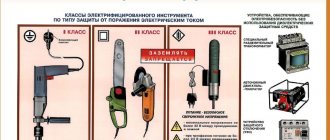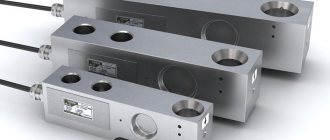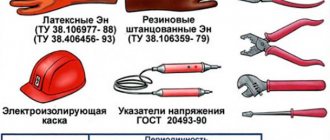Organizational measures for electrical safety when working in electrical installations concern the creation of conditions for the implementation of measures to protect people from possible electric shock and from other factors that threaten life and health. The rules are mandatory for enterprises and institutions by law; violation is fraught not only with reprimands, dismissals, non-payment of insurance, but also administrative (bans, fines) and, in special cases, criminal liability. The life and health of people directly depends on organizational measures, as well as on technical ones.
What are organizational safety measures for electrical equipment
Electrical safety (electrical safety) measures are divided into organizational and technical: the first are actions to create an environment for the most effective implementation of the second.
What do organizational accident-free actions include:
- in general terms: creating conditions (the very possibility) for trouble-free work process;
- management;
- control;
- supervision;
- orders, orders, lists of acceptable actions;
Two aspects of organizational ES measures:
- registration of events with documentary support: orders, lists, assigning a circle of responsible persons, technical and special methods;
- implementation of the above (control, supervision, directions, instructions).
Monitoring activities imply constancy, periodicity, and operate throughout the entire period of operation of the power plant from the moment the need arises until completion. The moment of completion is not only the complete completion of a technological operation, but also the removal of all workers from the equipment with documentary registration (technical, operational), excluding return without a new permit to the same place.
Officials responsible for safe interaction with electrical installations undergo (according to Procedure 1/29):
- training, including that on labor protection in institutions of the Ministry of Labor of the Russian Federation, self-government bodies;
- annual confirmation of the ES group.
Sources
The topic of safety on electrical equipment is extremely broad; standards on it are contained in narrowly focused documents, and in labor protection acts, in the PUE. Organizational measures and technical measures that ensure the safety of work in electrical installations are interconnected and always overlap.
Detailed information with explanations and explanations of individual points is contained in educational, lecture (for example, life safety departments of universities), methodological and recommendation materials.
The list of sources below is not exhaustive, but sufficient to guide the reader when searching for information, since there are many textbooks and interdisciplinary acts with standards on the issue under consideration.
Sources:
- rules: technical operation of consumer electrical installations (PTEEP);
- on labor protection (LOS) during operation. EU (Appendix of the Ministry of Labor N 328n);
- electrical installation devices (PUE);
Why creating safe conditions for activities with ES is mandatory
It is not enough just to use technical means to preserve health when interacting with electrical installations - without proper organization they will not have the required effect.
Organization of electronic security is important for the following reasons:
- human consciousness is subject to distractions, fatigue, forgetfulness, reflexes, and deterioration of concentration. Attention is weakened by irritating environmental factors, it can switch to another event, and the hands can mechanically continue to act, making already dangerous movements. No matter how well security is implemented from a technical point of view, if there is no proper administration, its effectiveness decreases;
- The electrician may forget and not be warned about the features and innovations of the electrical installation. Constant monitoring and reminders are one of the goals of the measures;
- it is necessary to constantly check competence, improve and ensure the level of knowledge and skills;
- control over the exclusion of drunk, sick, and excited people is mandatory by default;
- It is prohibited to manipulate the EC hastily, without preparation. The need for planning, careful thinking is always necessary.
Purpose and list of events
The main objective of organizational measures is to ensure the proper level of safety during the work of electrical personnel. For this purpose, special procedures have been developed; we list them in order of priority:
- Formulation of the problem . This may be an order, order or list of works provided for by the operating procedure for electrical equipment (equipment inspection, maintenance, etc.).
- Registration of admission. This stage includes checking for the presence and compliance of electrical safety groups among the personnel (crew). In addition, the degree of preparation of the work site is checked after completing the prescribed technical measures (removing power from live elements, installing portable grounding conductors, hanging warning signs, etc.). At this stage, induction training is also required.
Conducting induction training - Appointment of a controller responsible for electrical safety.
- Organization of a break, transfer to another site and procedure for completing work.
Who is responsible, types of subjects
There are several types of responsible persons when implementing organizational security controls. Each has its own scope of powers, but they are allowed to be combined in certain cases.
The scope and granting of rights, including the authority for sole actions, is fixed by order of the management of the facility.
| Subject type | Authority | Requirements |
| Issuer of orders, orders, lists | Scope of control and responsibilities:
Conducts briefings for all the persons listed below, except for admitters and performers. |
|
| Responsible manager | The need for it is determined by the issuer. Required when employed with equipment from 1 kV; up to 1 kV is not assigned. Monitors the creation of an accident-free environment, the implementation of additional and additional measures. Authorized to provide targeted briefings for performers, responsible for them, and supervises the implementation of this procedure by the two persons listed below. | |
| Permissive | Responsible for admission, for instructions for performers, for the correctness of measures, which he compares with documents and conditions. |
|
| Manufacturer | Scope of responsibility:
|
|
| Watching | The same as the previous person, but these persons are appointed for supervision when employees do not have the authority to act independently in the management authority. According to the text, when mentioning the manufacturer, the observer is implied and vice versa (depending on whether the specified circumstance exists). | Worker with gr. III. |
| Team composition (performers) | The person at the head of this formation is responsible for the trouble-free technology and is always present at the site. His full name is prescribed in the work order (in the “Separate Instructions”). The responsibility of each participant is to adhere to the provisions and instructions of the POT, briefings, instructions, and responsible entities. | The main requirements for the composition of the team: at least 2 people, usually the manufacturer and its participant. Determining factors of parameters:
If the manufacturer heads the formation, then its participant must have III gr. according to EB, and when employed on overhead lines - IV. For each member from III gr. 1 person from group II is allowed, but the total number is up to 3. |
Organizational measures in electrical installations
Organizational measures in electrical installations include:- issuing an order or order;
- permission to work;
- supervision during work performance;
- transfer to another workplace, registration of breaks in work and its end.
Responsible for the safe performance of work and the implementation of organizational measures in electrical installations are:
- issuing order, order;
- permissive;
- responsible work manager;
- work producer;
- watching;
- brigade members.
The issuing order or order is responsible for the need to perform the work, for the sufficiency and correctness of safety measures, for the appointment of responsible persons and the compliance of their qualifications with the assigned work. The right to issue orders and instructions is granted to employees from the administrative and technical staff who have Group V.
The work manager is responsible for implementing safety measures, instructing the team and organizing safe work; appointed from among the engineers of group V.
The permitter is responsible for the correct implementation of the safety measures provided for in the work order and for the correct admission to work. It must have a group of at least III in electrical installations up to 1000 V, and not below IV in installations above 1000 V.
It is prohibited to change the measures for preparing workplaces provided for in the work order. If an opinion arises regarding the sufficiency or correctness of these measures, preparation should be stopped. Before admission, the manager and the person performing the work must find out from the person admitting exactly what measures have been taken and check the preparation by personal inspection of the workplace. Admission to work according to orders is made directly at the workplace after it has been checked. In this case, the admitter must:
- check the compliance of the brigade composition with that specified in the order according to the personal identification cards of the brigade members;
- conduct instructions, indicating the boundaries of the workplace and live parts that remain energized;
- prove to the team that there is no voltage by showing the installed grounding connections, and in electrical installations up to 35 kV, in addition, by touching live parts with your hands.
The work foreman also instructs the team, paying attention to installation technology, the use of tools, machines and mechanisms. If necessary, the work manager can supplement the instructions. Without briefing, admission of the brigade is prohibited.
We read additionally:
Protective means in electrical installations
Safety of work in electrical installations
Work permit
The work permit is a task and a tool for authorization, the basis for ensuring electronic security. You will need 2 copies, and when transferring remotely - 3 copies. and at the same time, the issuer fills out 1 copy, and the receiver fills out 2 copies. and writes his full name in place of the signature of the first, certifying the data with his signature. The quantity of the specified organizational instrument for one responsible person is determined by the issuer. You can issue several of them (as well as orders) for sequential execution.
For the document in question there is a special form that defines:
- for work: possible actions, goals, time, safety conditions;
- performers, responsible persons.
Validity and storage periods for outfits:
- up to 15 cal. days from the start date of work;
- extended no more than 1 time per 15 cal. days;
- remains relevant during breaks;
- another employee with the right to issue a document for the used EC has the right to renew;
- store for 30 days. after execution, then destroyed.
The procedure for setting the task
Having dealt with the responsible persons, let’s look at how the task is set, using the example of the rules for drawing up a work order.
Work permit for work
The work order must be issued before the process of preparing the place of work begins. Registration of an outfit in advance is unacceptable. Two copies of this document are always prepared. Amendments to the document are prohibited.
The task can be handed personally to the person responsible for execution or transmitted to him in the form of a telephone message. In the latter case, the one who receives the telephone message fills out the form, indicating the position and full name of the person who issued the permit, and then certifies the received document with a signature. The telephone message can be received by the manager or operational personnel servicing this facility. The document obtained in this way has the same status as the permit.
Receiving a telephone message
To perform tasks of the same type, which do not require shutting down electrical installations, a general work permit may be issued for sequential work execution. As for the registration of transfers to other places of work, this procedure is mandatory if a transfer to another RU or change of floor is made. If live parts of electrical installations are disconnected, including terminals of overhead and cable lines, and access to adjacent electrical equipment that is energized is blocked, then the issuance of a general permit for all connections is permitted.
Order
Characteristics of orders:
- are issued to supervisors and admitters, and if the establishment does not have operational service personnel or when admission is not needed, then directly to employees;
- are one-time tasks for small volumes of actions. They determine what needs to be done, the timing, the place, what needs to be done according to the security, the suitability of the persons;
- term - working hours;
- in case of extension, change of circumstances, replacement of performers, they are given anew;
- re-entry during pauses during the day is issued by the manufacturer;
- can be written out to perform tasks one at a time.
Work on the described document is possible at the discretion of the issuer and according to the order. Tolerances for it are recorded in accounting and operational books. In power plants from 1 kV, emergency manipulations can be carried out by personnel or under their control by repair staff, but up to 1 hour (not taking into account preparation).
Lists
Allowed minor manipulations during a shift are included in a pre-created list. The technical manager or the person responsible for electrical equipment has the right to sign the document, and the facility manager approves the document.
Requirements for actions on the lists:
- always permitted, ongoing operation;
- EI up to 1 kV;
- by the operational personnel on the equipment assigned to them;
- preparation is done by the same workers;
- briefings and similar procedures are not mandatory;
- The list includes manipulations: in equipment with one-sided power supply;
- manipulations with cables and wires, having the nature of connecting/disconnecting;
- repair of start-up, switching, but only when located outside of panels and assemblies;
- repair of separately located electrical receivers (motors, air heaters), magnetic installations, control units;
- maintenance of brush structure elements;
- installation/dismantling of accounting, measuring instruments, fuses;
- maintenance of lighting fixtures, wiring, replacement of lamps at a height of up to 2.5 m;
- the list may include other works by the head of the enterprise.
Requirements for compiling the list:
- take into account the importance of the entire power plant or 10 of its functional parts, the environment, personnel qualifications, and the possibility of individual implementation;
- contains rules defining permitted manipulations;
- the procedure for recording actions is prescribed (reports to superior personnel about all stages, aspects, etc.).
Initial admission, preparation
The specified measures can be carried out only after its authorization by operational employees in charge of the electrical installation or a person appointed by the management of the facility.
Restrictions:
- it is prohibited to give out before the arrival of the performers;
- Admission is possible according to 1 order, order.
The provisions of the training order cannot be changed. If the manufacturer allows one person, then one of the performers with III gr. is involved in the event.
The admitter verifies the preparation by inspecting the object, checking with logs, operational data, messages, and then grants admission. Next, the manager and the supervisor find out from him what has been done, then they do a joint inspection by inspection. If there are no operational employees (but with their permission), the check can be performed by two specified persons.
Admission is made directly on site after checking the preparation. When the latter is not required and the work is carried out by order, the specified event is not mandatory, and it is not done on overhead lines, overhead lines, cable lines. Registration consists of marks and signatures on the orders. A record is made in 2 copies. of this document: for the observer and the admitter, and if this is one person (combining responsibilities), then in 1 copy. A mark is placed in the accounting books and operational data.
Preliminary actions of the person admitting:
- checks the identity of (groups of) performers;
- proves that there is no voltage: shows grounding or checks in another way. In power plants up to 35 kV, it is verified by touching, if possible, current-carrying elements.
Targeted briefings
Before the start of work, the team is required to carry out targeted briefings along a certain chain, sequentially from the issuing person. Admission is prohibited without the specified event.
Instructions are carried out:
- The issuing one is the manager, and if there is none, then the manufacturer.
- Admitting - the first two persons specified in the previous paragraph, as well as the composition of the team.
- The manager is the team and the manufacturer, who, completing the chain, instructs the workers.
Chain of instructions, if actions are carried out by order (can be carried out by telephone):
- Issuer - producer or performer.
- Admitting - the same persons indicated above.
- When a new participant is introduced, he is instructed by the manufacturer.
Supervision, change of team
Supervision is the competence of the manufacturer (manager), he also controls all actions and is located in the most dangerous area. He is prohibited from combining this duty with other activities. When leaving the facility, if replacement is not possible, he is obliged to remove employees from the control unit by removing it from the switchgear (switchgear) and locking the entrances.
It is prohibited to remain in equipment from 1 kV without the manufacturer or to him alone. Temporary departure of employees without removal from the staff is allowed, with the latter’s permission. But in power plants from 1 kV there should be at least 2 performers (together with the manufacturer). Those who are from III gr. can leave and return independently, and persons with II gr. - only with an employee with III grade. or with the right of sole action. In this case, it is forbidden to leave the entrance unlocked. Returnees begin to perform their duties after instructions from the manufacturer.
When you need to issue orders again:
- replacement of supervisors;
- the environment, work parameters or more than half of those performing have changed.
How is supervision carried out?
As already described above, monitoring the process of solving the problem is assigned to the controller. In some cases, at the discretion of the person issuing the work order, this position may be held by a performer who is not directly involved in the repair.
The controller must be present on site for the entire duration of the task (except for breaks). If the site involves several areas, then you should be located on the most critical one.
The performing team is allowed a short absence. In such situations, the controller is instructed to give appropriate safety instructions to everyone leaving the site. After returning, they can begin to perform their duties only with the permission of the controller. The latter is prohibited from leaving the site until those who were absent return.
If the controller needs to leave the site for a short time, he can be replaced by a performer who is not directly involved in the technical process. Otherwise, workers should be removed from the site. This can be done by scheduling a break.
Breaks, re-admissions
Actions during pauses caused by lunch, the nature of the actions performed:
- the performers are removed, the control room is locked with a padlock;
- workers are prohibited from returning without the manufacturer, who keeps the work order, and he also allows them after such a pause, and no mark is needed.
During breaks due to the end of the day:
- the object is completely freed from performers;
- auxiliary, protective structures (signs, etc.) are left;
- the manufacturer hands over the work order to the admitting person or leaves it in a special place (in a folder). In an EU without operational staff, you can keep the paper at home.
The finish of the work is recorded by the manufacturer in his copy of the work order. Admission on subsequent days is carried out by the admitter or, if authorized, by the manager without permission from a superior employee from the operational staff. If there is the consent of the person admitting, then the team can be admitted if there is an order, but this must be accompanied by an entry in the “Separate instructions” column.
When starting actions the next day, the manufacturer verifies the integrity of the safety structures left behind (signs, grounding), allows and registers this in the work order. If the last action is carried out by an admitter from the operational staff, then records are made in 2 copies.
Procedure for obtaining permission to work
Here is the sequence of stages of this organizational procedure:
- Before permission to carry out work is given, the implementation of electrical safety measures is checked. Control is carried out by the admitter together with the performer and the responsible manager.
- If no violations are identified during the inspection, an introductory briefing is carried out and a corresponding entry is made in the permit.
Important! It is prohibited to make changes to the procedure described above.
After the listed activities, the responsible person proceeds directly to the admission of the team. This procedure consists of the following steps:
- Checking the composition and qualifications of performers.
- The team is explained the task and the technical electrical safety measures taken. That is, it explains which current-carrying parts were de-energized, where portable grounding was applied, etc. In addition, information about the established boundaries of the place of work is brought to the attention of performers.
- A demonstration of the absence of voltage at the work site is carried out. To do this, it is enough to show the applied grounding to live parts. If the grounding conductors are not visible from the work site, then the demonstration can be done visually (the permitter touches the current-carrying elements of the electrical installation, having first checked the absence of voltage using standard means).
- The place of work is transferred to the contractor, which is recorded in the work permit and certified by the contractor and the permitter. A corresponding entry is also made in the operational journal.
An example of operational journal design
Completion of work, delivery and acceptance
Actions of the observer (the first 2 points are also performed by the leader):
- after the performers have fully achieved their goals, they are removed, places are checked, fences, signs, etc. are removed, and the entrance to the control center is locked;
- registers final completion in the work order and confirms this with a signature;
- notifies the duty officers or the person who issued the order about the end;
- the outfit is handed over to the admitting person or left in a special folder. The latter, having received the document, makes an inspection and informs a higher-ranking employee from the operational staff about the completion of all manipulations and that the electrical equipment can be activated.
The completion of work after assessing the condition of workplaces is confirmed by a mark in the accounting books and journals.
Break, transfer to another site and completion of the task
If, according to the conditions of the production work cycle, a break time comes, then the team of performers must be removed from the site. In this case, the controller keeps the permit with him, and all technical electrical safety equipment remains installed on the site.
The team of performers is prohibited from returning to the work site on their own after a break. This is done only on the instructions of the controller.
If an emergency situation arises in which it is necessary to connect de-energized electrical installations during a break for a group of performers, then this is allowed only if the following requirements are met:
- Electrical safety equipment installed during technical measures must be removed from the work site.
- Warning signs and barriers are installed in their original positions.
- At the approaches to the site, it is necessary to place persons from the operational staff to warn the controller about the impossibility of continuing the interrupted task.
Change of site.
If work is planned at different sites, the following requirements must be observed:
- Each work site is carefully checked by an inspector in accordance with the instructions stated above.
- A team of performers can only be admitted to one work site.
- The transfer of performers to a new site is carried out by the permitting or responsible manager.
- A record of the transfer is made in the relevant documents.
Completing the task.
Upon completion of the task at the site, the site must be put in order. The team of performers is removed from the work site. The result of their activities is checked and accepted by the responsible manager, making an appropriate entry in the accounting documents, after which he transfers them to the operational staff member. Information about the completion of the assigned task is also entered into the operational log.
Work can only be accepted after complete removal of electrical safety equipment from the site, including warning signs.
Turning on the equipment after finishing work
The person authorized to activate the installation first checks its readiness: cleanliness, absence of signs, etc., permanent structures removed before work are restored.
If the person admitting is one of the operational and repair employees, then he may be given the authority to activate the equipment without authorization or order. This feature is noted in the “Separate Instructions” order and this is only possible if other teams are not allowed to the control center.









